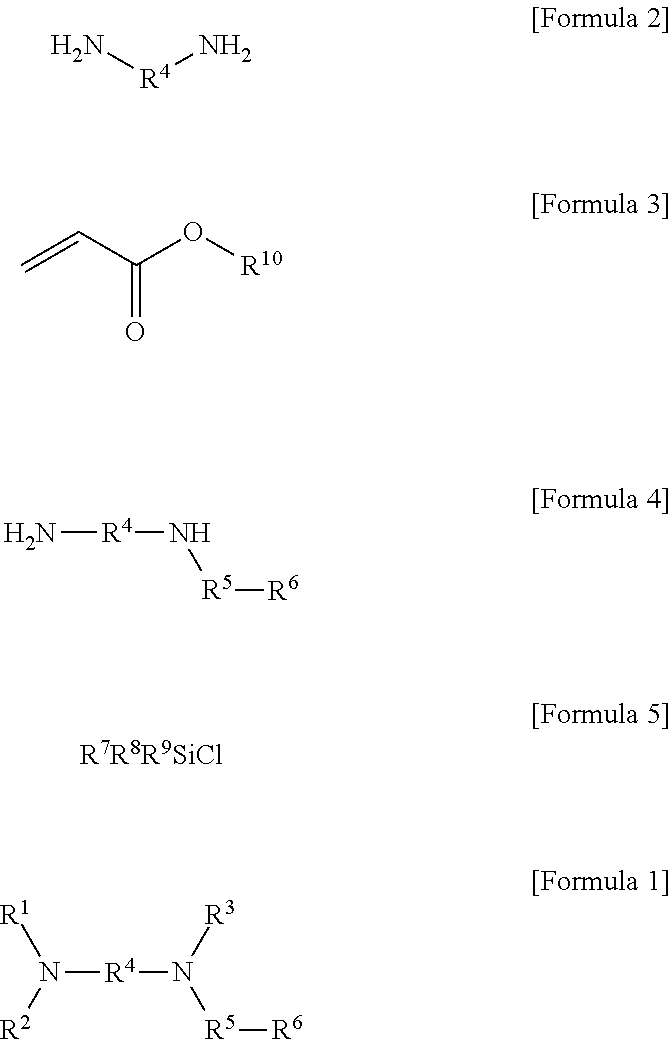Modified Conjugated Diene-Based Polymer And Method Of Preparing The Same
a conjugated diene-based polymer and modified technology, applied in the field of modified conjugated diene-based polymers and methods of preparing the same, can solve the problems of reducing physical properties, br or sbr with the filler, and reducing wet skid resistance of rubbers, so as to achieve excellent affinity, easy to react, and high anionic reactivity
- Summary
- Abstract
- Description
- Claims
- Application Information
AI Technical Summary
Benefits of technology
Problems solved by technology
Method used
Image
Examples
preparation example 1
[0175]1) Preparation of Compound Represented by Formula (i)
[0176]After 46.5 g (400 mmol) of hexamethylenediamine and 400 ml of tetrahydrofuran (THF) were added to a 1 L round-bottom flask, 48.1 g (480 mmol, 1.2 eq) of ethyl acrylate was slowly added thereto. Thereafter, a reaction was performed while stirring for 12 hours at room temperature, and, after the complete consumption of the hexamethylenediamine was confirmed, the reaction was terminated and the solvent was then removed under reduced pressure. Thereafter, 500 ml of n-hexane was added and the solution was filtered using a celite pad and concentrated to obtain a compound represented by the following Formula (i) (yield 80%). 1H nuclear magnetic resonance spectroscopic data of the obtained compound represented by Formula (i) are as follows.
[0177]1H-NMR (500 MHz, CDCl3) δ 4.13 (2H, q, J=7.2 Hz), 2.86 (2H, td, J=6.5 Hz, 1.5 Hz), 2.67 (2H, td, J=7.0 Hz, 3.5 Hz), 2.59 (2H, td, J=7.1 Hz, 3.2 Hz), 2.49 (2H, t, J=6.5 Hz), 1.50-1.40 (...
preparation example 2
[0183]1) Preparation of Compound Represented by Formula (i)
[0184]After 46.5 g (400 mmol) of hexamethylenediamine, 111.6 g of aluminum oxide, and 400 ml of tetrahydrofuran (THF) were added to a 1 L round-bottom flask, 48.1 g (480 mmol, 1.2 eq) of ethyl acrylate was slowly added thereto. Thereafter, a reaction was performed while stirring for 12 hours at room temperature, and, after the complete consumption of the hexamethylenediamine was confirmed, the reaction was terminated and the solvent was then removed under reduced pressure. Thereafter, 500 ml of n-hexane was added and the solution was filtered using a celite pad and concentrated to obtain a compound represented by the following Formula (i) (yield 95%). 1H nuclear magnetic resonance spectroscopic data of the obtained compound represented by Formula (i) are as follows.
[0185]1H-NMR (500 MHz, CDCl3) δ 4.13 (2H, q, J=7.2 Hz), 2.86 (2H, td, J=6.5 Hz, 1.5 Hz), 2.67 (2H, td, J=7.0 Hz, 3.5 Hz), 2.59 (2H, td, J=7.1 Hz, 3.2 Hz), 2.49 (2...
preparation example 3
[0190]1) Preparation of Compound Represented by Formula (ii)
[0191]After 29.7 g (400 mmol) of 1,3-diaminopropane and 400 ml of tetrahydrofuran (THF) were added to a 1 L round-bottom flask, 48.1 g (480 mmol, 1.2 eq) of ethyl acrylate was slowly added thereto. Thereafter, a reaction was performed while stirring for 12 hours at room temperature, and, after the complete consumption of the 1,3-diaminopropane was confirmed, the reaction was terminated and the solvent was then removed under reduced pressure. Thereafter, 500 ml of n-hexane was added and the solution was filtered using a celite pad and concentrated to obtain a compound represented by the following Formula (ii) (yield 85%). 1H nuclear magnetic resonance spectroscopic data of the obtained compound represented by Formula (ii) are as follows.
[0192]1H-NMR (500 MHz, CDCl3) δ 4.13 (2H, q, J=7.2 Hz), 2.86 (2H, td, J=6.5 Hz, 1.5 Hz), 2.67 (2H, td, J=7.0 Hz, 3.5 Hz), 2.59 (2H, td, J=7.1 Hz, 3.2 Hz), 1.47 (2H, m), 1.25 (3H, t, J=7.3 Hz)...
PUM
| Property | Measurement | Unit |
|---|---|---|
| temperature | aaaaa | aaaaa |
| temperature | aaaaa | aaaaa |
| molecular weight distribution | aaaaa | aaaaa |
Abstract
Description
Claims
Application Information
 Login to View More
Login to View More - R&D
- Intellectual Property
- Life Sciences
- Materials
- Tech Scout
- Unparalleled Data Quality
- Higher Quality Content
- 60% Fewer Hallucinations
Browse by: Latest US Patents, China's latest patents, Technical Efficacy Thesaurus, Application Domain, Technology Topic, Popular Technical Reports.
© 2025 PatSnap. All rights reserved.Legal|Privacy policy|Modern Slavery Act Transparency Statement|Sitemap|About US| Contact US: help@patsnap.com



